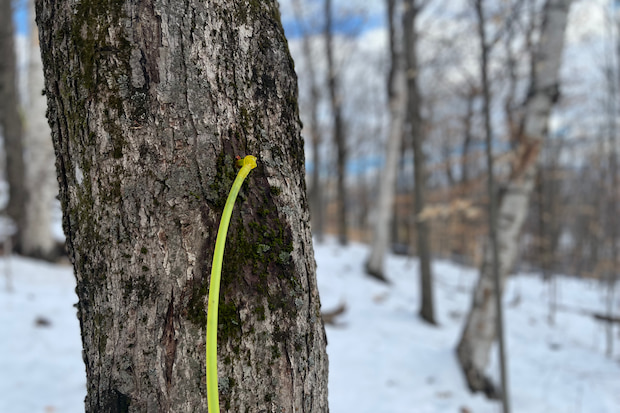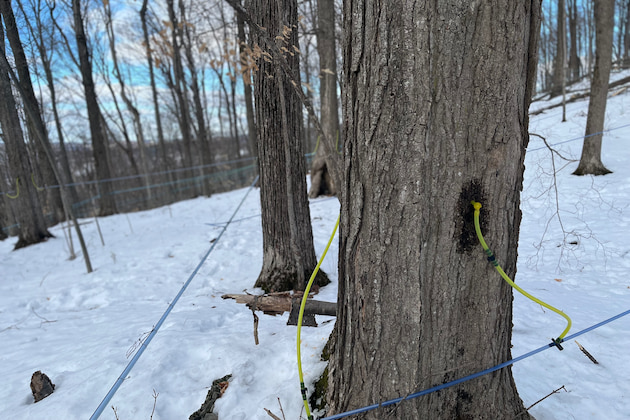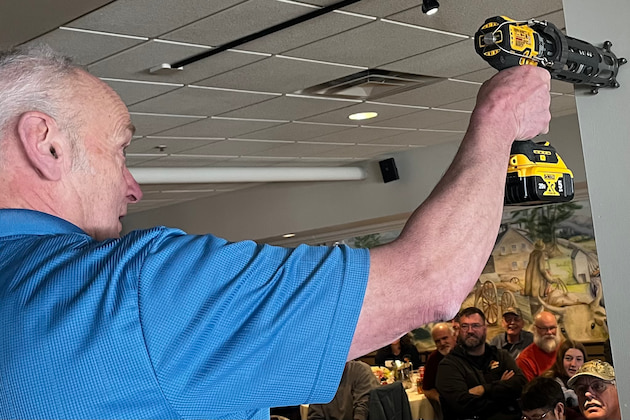Tapping & Tubing
What to do about weepy tapholes?
Uneven drilling is the cause, say experts
By PETER GREGG | FEBRUARY 10, 2023
FAIRFIELD, Vt.—What to do about weepy tapholes?
As sugarmakers across the U.S. race into the woods this week during an unusual warm-up, some are scratching their heads over a common phenomena—sap leaking out of the taphole and spreading around the trunk.
Expert tappers generally agree that the leaks are caused by poorly drilled holes.
“Wobbly or oval holes, I would say is the cause,” said Evan Branon of 80,000-tap Branon Family Maple Orchards in Fairfield, Vt. Branon is the inventor of the Precision Tapper, a drill attachment sold by CDL that helps the sugarmaker drill consistent and straight holes in the tree.
Still, for those who don’t own that equipment, sugarmakers can ensure proper holes by using good technique.
“We always want to use two hands to steady the drill,” said 160,000-tap sugarmaker Glenn Goodrich of Goodrich Maple Farms in Cabot, Vt. who led a seminar on tapping at the New Hampshire maple school last month.
Goodrich said that if a sugarmaker finds a weepy hole after drilling, he/she should not go back and pound the tap in harder with the mallet.
“Just leave it alone and check back on it in a few days,” he said, suggesting that the hole oftentimes will seal up on its own.
Steve Childs, a maple hall-of-famer and former director of the Cornell Maple Program, agreed.
“I would wait for a couple of runs to see if it seals up,” Childs told The Maple News. “If you see significant air entering the line then yes some extra taps on the hammer would be in order.”
Branon said that polycarbonate spouts seat the best when using a Precision Tapper device. If not, then use flexible nylon spouts, which can wriggle into tapholes that may be uneven.
Childs had more advice: “Sometimes using a hard spout allows weeping to show up more, especially if holes are not perfect,” he said. “A dull bit can leave shreds that wick a little sap out.”
Meanwhile, sugarmakers are encouraged to use good tapping practices to achieve long term sustainability.
That means producers should probably go for a two inch tapping depth, according to researchers at the UVM Proctor Maple Research Center in Underhill, Vt. Any more and there’s no difference in yield.
“Two inch depth gives you the most bang for your buck,” Proctor’s Dr. Abby Van den Berg has told The Maple News.
Also, it might be best to stay away from smaller diameter trees. Tapping trees less than 10 inches in diameter not only produces less sap, it also creates less tappable surface on that tree, handicapping its production over time.
“Non-conductive wood will accumulate faster in smaller trees,” she said.
And don’t bother with two taps in the same tree either.
“In smaller trees the vacuum cannibalizes sap from the other hole,” van den Berg said.
Other tips include using longer drop lines, ideally of 36 inches, giving the sugarmaker more options for finding conductive wood.
Tapping below the lateral line is also an accepted new practice that allows for more optimal tapping locations.
“Aim for the tapping practices to maximize getting the most sap at the time and not shooting yourself in the foot ten years from now,” van den Berg said.


































